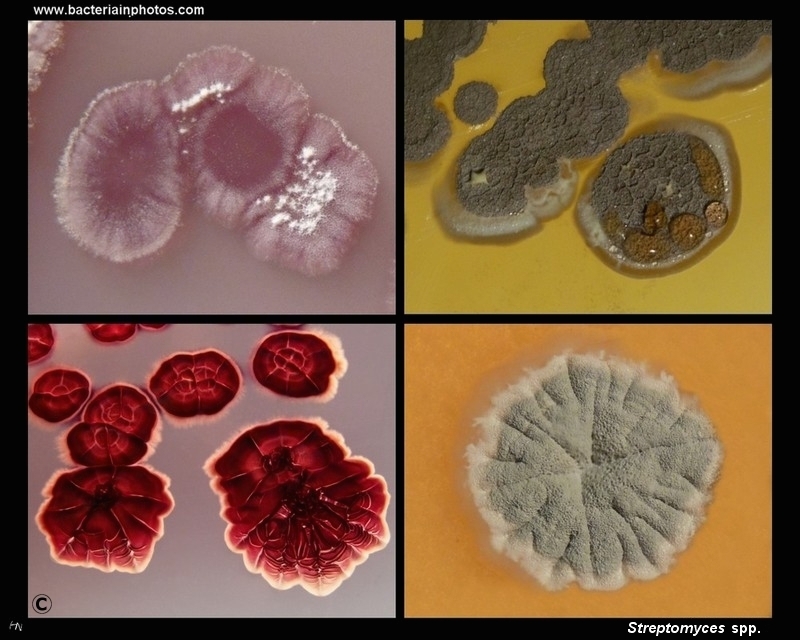Streptomyces sp. It has been widely recognized as an important industrial microorganism due to its potential in the diverse production of secondary metabolites including antibiotics, antitumor agents, antiparasitic agents, inhibitors. Immune preparations and enzymes.
Some active ingredients and typical products from actinomycetes:
-Antibiotics: streptomycin, erythromycin, tetracylin, neomycin, chloramphenicol, vancomycin, gentamicin.
– Antifungal drugs: Nystatin, amphotericin.
-Cancer medicine: doxorubicin, bleomycin, mitomycin.
– Immunosuppressant drugs: rapamycin.
-Herbicide: bialaphos.
Overview and potential of actinomycetes application in agricultural production
What is streptomyces?
Bacteria (scientific name: Antinobacteria; English: Actinomycetes) is a group of real bacteria (Eubacteria) widely distributed in nature. Previously classified Scattering plants (fungi), but today are classified as bacteria (Schizomycetes).
Classification of actinomycetes Streptomyces
Streptomyces is the largest genus of Actinobacteria and is a branch of Streptomycetaceae.
To date, more than 500 species of streptomyces have been described.
Like most Actinobacteria, Streptomyces is a Gram-positive (+) bacterium, having a genome with a high GC ratio. This bacterium is found mainly in decaying soil and vegetation.
Streptomyces bacteriological characteristics
Streptomyces is a mushroom-like structure, so some people mistakenly believe Streptomyces is a fungus. Their branches are arranged in filamentous cells in a network called hyphae. They can metabolize various compounds including sugar, alcohol, amino acids and aromatic compounds by producing extracellular hydrolytic enzymes. Because of their large genes, their metabolism is also diverse, including hundreds of transcription factors that control gene expression, allowing them to meet specific needs.
Spore-forming Streptomyces, which produces a characteristic odor, results from geosmin production in the metabolism of substances.
Streptomyces is widely studied and is best known as the genus of actinomyces (Actinomyces).
Streptomyces culture medium
In order to isolate Streptomyces, plate agar is usually used with dedicated environments such as GauseI, GauseII, Krasilnicov environment, ISP environment system.

Culture of Streptomyces bacteria on agar plates
The role of Streptomyces
Streptomyces usually lives in soil and plays a very important role in compost microorganisms. One of the most important characteristics of Streptomyces is the ability to form antibiotics. Of the 8,000 antibiotics currently available in the world, more than 80% are derived from actinomycetes.
Antibacterial-derived antibiotics have quite a broad spectrum of resistance; antibiotics are selective.
Antibacterial ability of antibiotics is an important characteristic to classify actinomycetes. Many actinomycetes have the ability to synthesize two or more antibiotics with similar chemical structure and effect. The process of antibiotic biosynthesis depends on the mechanism of multi-gene regulation, in addition to the genes responsible for antibiotic synthesis, there are enzymes responsible for the synthesis of precursors and cofactor.
Application of Streptomyces in agriculture
The use of antibiotics in farming aims to combat fungal diseases on vegetables and crops, against bacterial diseases, kill insects and weeds … to control plant diseases. born from the land.
Compared with chemical drugs, the use of antibiotics in plant protection has a fast-acting, easily biodegradable, highly selective effect, low toxicity does not pollute the environment, and has the ability to inhibit microorganisms that have been chemically resistant. Antibiotics and fermentations of antibiotic strains also treat seeds with the purpose of killing pathogens on the outside and inside the seeds, killing diseases on the soil parts of plants and eliminating coincidence.
The antagonism among microorganisms in the soil is the basis of the disease prevention measure. The presence of antagonistic actinomycetes in the soil significantly reduces the incidence of plants. Usually an antagonistic bacterium can inhibit some pathogenic fungi but there are broad active species that can inhibit many pathogens present in the soil.
Not all antifungal activity in vitro are all present in soil (about 4 – 5%) but they play an important role in inhibiting fungal pathogens and preventing the likelihood of infection. This is the law of biological balance in nature. If the balance is lost, disease will immediately arise when soil pathogens are available.
Antibacterial antifungal in addition to antibiotic secretion also works on the microbiota through the enzymes that break down. In addition, many actinomycetes also secrete plant growth as well as stimulate beneficial microflora areas in the root zone.
In 2002, India was isolated strains Streptomyces sp. 201 is capable of producing new antibiotic z – methylheptyl iso – nicotinate, this antibiotic is resistant to many pathogenic fungi such as Furasium oxysporum, Furasium solani …
In Vietnam also use many antibiotic preparations in plant protection imported from China, Japan … and has isolated a number of strains of actinomycetes that can resist Pyricularia oryae causing blast and F. oxysporum causing root rot in plants. However, the use of antibiotics in the field of plant protection in our country is still at a very low level because the farming practices are used to using certain pesticides.
Read more : >> Preventing diseases that cause pepper damage when the weather changes
According to the Wikipedia, FistaNet
